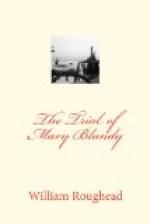In the spring of 1749, “a few months” after Cranstoun’s departure, Miss Blandy and her mother went to London for the purpose of taking medical advice as to the old lady’s health, which was still unsatisfactory. They lived while in town with Mrs. Blandy’s brother, Henry Stevens, the Serjeant, in Doctors’ Commons. Cranstoun, with whom Mary had been in constant correspondence, waited upon the ladies the morning after their arrival, and came daily during their visit. On one occasion, Mary states, he brought his elder brother, the reigning baron, to call upon them. This gentleman was James, sixth Lord Cranstoun, who had succeeded to the title on the death of his father in 1727. What was his lordship’s attitude regarding the “perplexing affair” in Scotland she does not inform us; but Mr. Serjeant Stevens refused to countenance the attentions of the entangled captain. Mrs. Blandy wept because her brother would not invite Cranstoun to dinner, and it was arranged that, to avoid “affronts,” she should receive the captain’s visits in her own room. But her friend Mrs. Pocock of Turville Court had a house in St. James’s Square. “Hither Mr. Cranstoun perpetually came,” says Mary, “when he understood that I was there;” so they were able to dispense with the Serjeant’s hospitality. One day she and her mother were bidden to dine at Mrs. Pocock’s, to meet my Lord Garnock (the future Lord Crauford). Cranstoun and their hostess called for them in a coach, and in the Strand whom should the party encounter but Mr. Blandy, come to town on business. “For God’s sake, Mrs. Pocock, what do you with this rubbish?” cried the attorney, stopping the coach. “Rubbish!” quoth the lady, “Your wife, your daughter, and one who may be your son?” “Ay,” replied the old man, “They are very well matched; ’tis a pity they should ever be asunder!” “God grant they never may,” simpered the ugly lover; “don’t you say amen, papa?” But amen, as appears, stuck in Mr. Blandy’s throat: he declined Mrs. Pocock’s invitation to join them, and shortly thereafter returned to Henley.




